Introduction
The older driver licensing system is designed to balance the safety of road users and the general community, whilst allowing the continued independence and mobility of older drivers and riders.
There is no upper age limit for any class of licence. When you reach a certain age, you must undergo a periodical medical examination and/or riding test as specified by Transport for NSW (TfNSW) to make sure you are medically fit to hold a rider licence. TfNSW sends a notice by mail eight weeks before your birthday.
TfNSW requires that you have an annual medical and a biennial (every two years) riding test even if you hold a three-or five-year licence.
Older rider overview
Compulsory medical reports
If you hold a rider licence you must provide a satisfactory medical report annually after the age of 75.
Older rider test / assessments 80 –84 years old
If you are between 80 and 84 years old and hold a rider (class R) unrestricted licence, you don’t need to take a practical riding test, although you must have a medical review every year to keep your licence.
You must pass all the reviews and assessments before your birthday each year. If you are not able to do this, you must contact Service NSW for advice.
Older rider test / assessments 85 and over
When you reach 85 you are required to have a medical review every year to keep your licence. You can choose, if you so wish, to have a modified licence. To keep your unrestricted motorcycle rider licence (Class R), you will need to take an aged Motorcycle Operator Skills Test (MOST) every second year. If you live in a declared area, contact your nearest Rider Training Provider to ask for an Aged MOST. If you live in an undeclared area*, contact a Service NSW centre by phone or in person to book an Aged Rider Kerbside Test.
* undeclared areas are those where a Rider Training facility is not within easy reach.
Modified licence
A modified licence lets you keep riding once you reach 85, under certain conditions. If you choose a modified licence, you do not need to attempt a practical riding assessment (Aged MOST). Modified licence conditions are printed on the back of the card. You must comply with the conditions on your licence when riding. For example, you may choose to ride only within a certain distance of your home, or only at certain times of the day. You should discuss options with your doctor, who can advise you on ways to keep you safe on the road. Once you are ready to apply for a modified rider licence, visit a Service NSW centre. The manager will discuss your individual needs with you and work out the conditions that meet your riding needs.
Practical Riding Test
You must satisfy the medical requirements that are needed to keep your licence before attempting a riding test.
If you live in a declared area, a Practical Skills Test (MOST) at a Rider Training Centre is required. You must contact a Rider Training Centre to schedule an Aged MOST. The Rider Training Centre will request approval for a free Aged MOST via TfNSW before confirming the booking. If you live in an undeclared area, a Kerbside Test at a Service NSW centre is required. You do not need to pay for an aged kerbside test, but motorcycle hire for the test is not available.
Older rider MOST test manoeuvres
During the practical riding test, you will be evaluated on a number of specific manoeuvres. The following information will help you practice these manoeuvres before taking the test. The MOST has been modified for the Aged Rider.
Left turn and stop in the box
* allowances are made for 3 wheeled motorcycles by:- 1/ those that are too wide to be able to make the left hand turn and remain within the yellow lines should treat the yellow lines on the left as a kerb and ride as close as possible to them. 2/ On a reverse trike (2 wheels at the front) stop with the front left wheel in the white box.
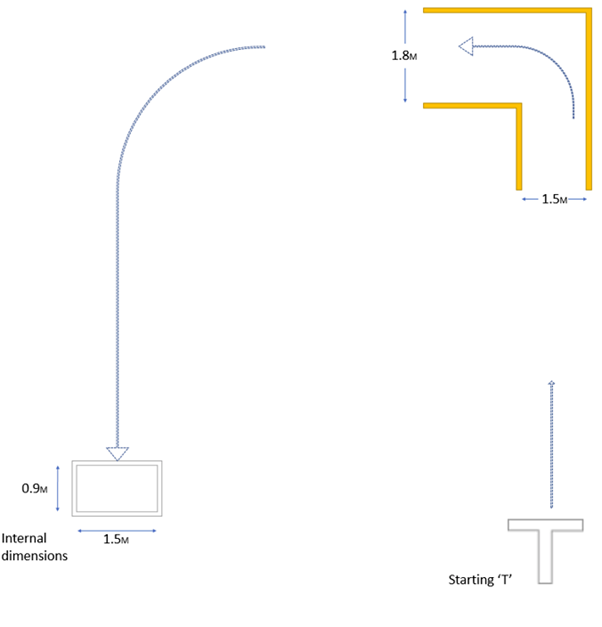
**Diagram supplied by “NAX Motorcycle Rider Training”
U-turn (two-wheel motorcycle and three wheeled motorcycles with a narrow front wheel track)
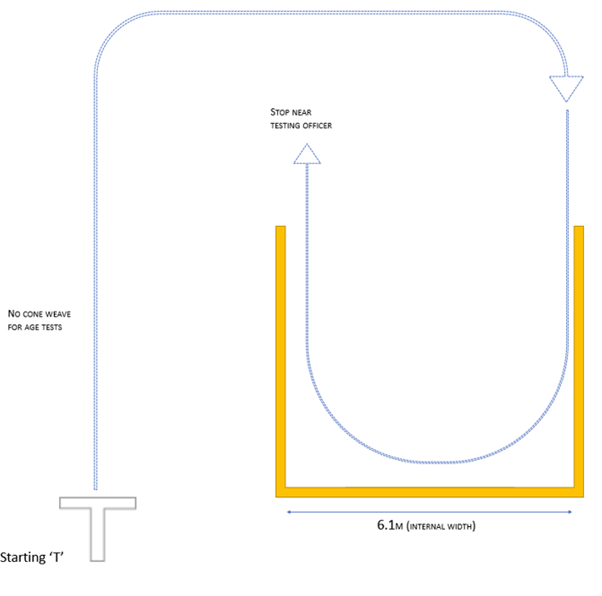
**Diagram supplied by “NAX Motorcycle Rider Training”
3 Point Turn (Trikes with 2 wheels at the back and Reverse Trikes with 2 wheels at the front)
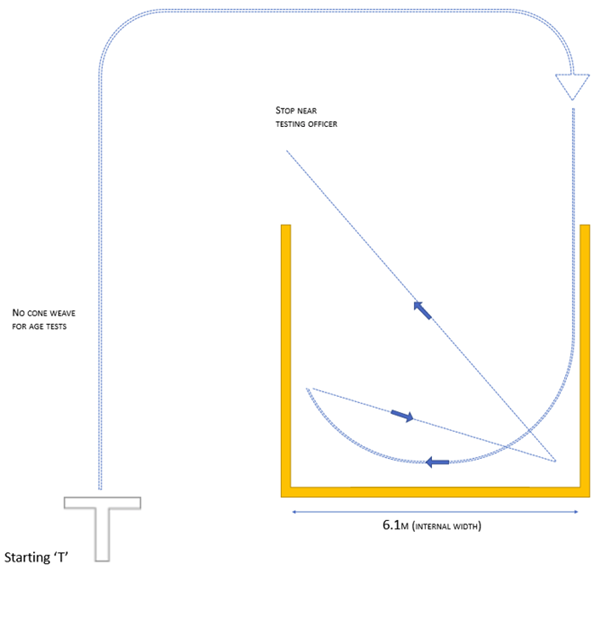
**Diagram supplied by “NAX Motorcycle Rider Training”
Braking
On the riding instructor’s signal proceed between the blue and yellow cones at a speed of 20 – 25km/h.
When the front edge of your front tyre passes the yellow cones, begin braking. The aim is to bring your motorcycle to a complete stop as quickly and as safely as you can. Skidding tyres is permitted
If you’re under 20km/h, you’ll be asked to perform a second stop.
If you brake early or prepare your brakes before the yellow cones, you’ll be asked to perform a second stop.
If you’re under 20km/h or brake early on the second attempt, it will be considered a fail.
You will accumulate points for:
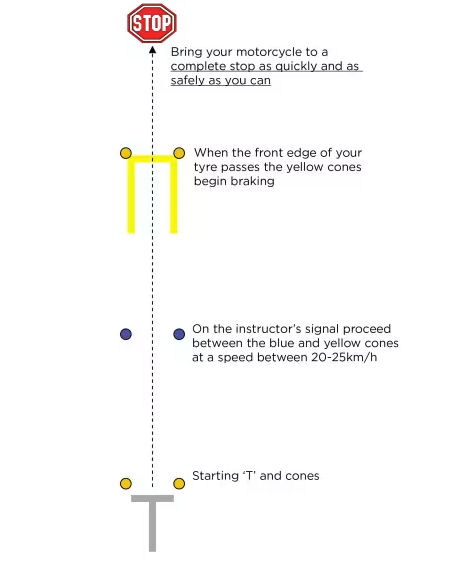
**Diagram supplied by “NAX Motorcycle Rider Training”
Note:- For a trike:-
1/ the blue and yellow cones will be moved further apart
Obstacle Turn
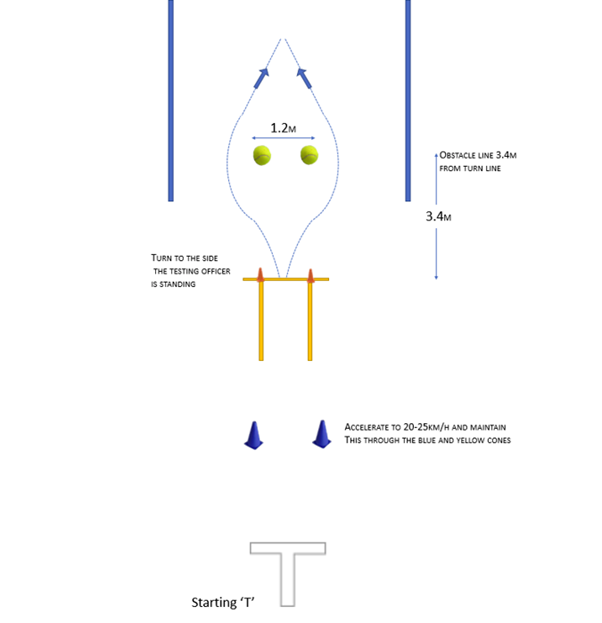
**Diagram supplied by “NAX Motorcycle Rider Training”
Note:- For a trike:-
1/ the blue and yellow cones will be moved further apart
2/ instead of 2 half tennis balls, one half tennis ball is placed in the centre
3/ there is no requirement to remain within the blue lines but you must turn back towards the centre
Kerbside Test
This test requires that you demonstrate to the testing officer that you have:-
* Note it is not intended as an exhaustive list of all of the manoeuvres you will be evaluated on, at your test
What happens next?
You’ll be notified of the result after the test.
You’ll receive a test report. This shows if you have passed or failed. It will show areas where you performed well and areas requiring improvement
If you pass
You can keep your licence if you have:
If you don’t pass
If you don’t pass the driver or rider test:
You can book to resit the test:
If you failed due to a serious error, your licence will be cancelled.
How to book to resit the Older Rider Riding Test.
If you live in a declared area, contact a Rider Training Centre to schedule an Aged MOST. If you live in an undeclared area, a Kerbside Test at a Service NSW centre is required. To be able to resit the Kerbside Test you will need to apply for a Learner Licence. This Learner Licence will allow you to ride on public roads while doing the Kerbside Test. The conditions of this Learner Licence must be strictly adhered to.
Alternatives to your current licence
You can opt for a modified licence which restricts your riding to the local area. If you choose this option, you may not need to resit the aged rider test.
You can retire from riding by returning your licence to a service centre. You can get a photo ID if you need one.
Taking the Matter to Court
If you believe your licence has been unfairly cancelled, you can take the matter to Court.
Contact Info
The Motorcycle Council of NSW Inc.
PO Box 517
Parramatta 2124
Ph: 1300 679 622 (1300 NSW MCC)
General Enquiries
Please direct enquiries to:
MCCNSW Email
enquiries@mccofnsw.org.au
Site Menu